Sri Lanka 2016
Colombo
Arrived and met by my taxi for a two night stay at The Gateway Hotel in Seeduwa,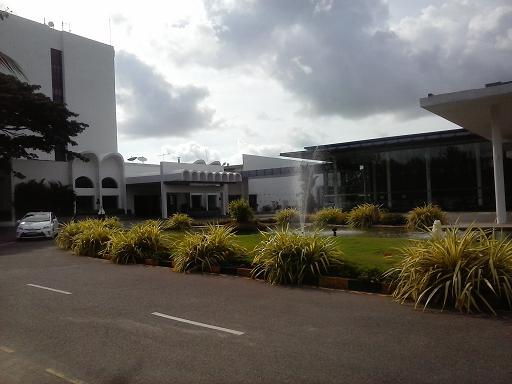 the hotel was only about 10 minutes from the airport with check in at noon, so I had a couple of hours to explore and enjoy the pool.
the hotel was only about 10 minutes from the airport with check in at noon, so I had a couple of hours to explore and enjoy the pool.
The Gateway is set in a 38 acre coconut plantation on the edge of the Negombo Lagoon and is split into two accommodation blocks, one of which houses the restaurant.
The quality of the food was excellent with not only Sri Lankan dishes available.
Colombo to Habarana
 There was a coach tour of Colombo which amongst others places included some of the more affluent districts like the Cinnamon Gardens area once the setting of a cinnamon plantation is now a nicer area of town that includes the Prime Minister’s office.
There was a coach tour of Colombo which amongst others places included some of the more affluent districts like the Cinnamon Gardens area once the setting of a cinnamon plantation is now a nicer area of town that includes the Prime Minister’s office.
Colombo’s Independence Memorial Hall which I thought looked somewhat like the Parthenon, has a statue of the first president of Sri Lanka who is considered one of the father’s of the nation. The Memorial was built in order to showcase Sri Lankan independence from British rule in 1948.
Also passing the cricket stadium, and the area known as Slave Island (named during British Colonial times), we made a picture stop at Murugan Temple.
Traffic in the city was horrendous and I was quite glad to be off and travelling to Habarana. On the way we passed pineapple farms and paddy fields.
Next two nights at the Cinnamon Lodge, accommodation here was in separate lodges. The hotel had its own organic farm and staff there were happy to explain the plants and processes The grounds had many tree species and exotic birds but also a very destructive group of monkeys who were only happy if they were running across the roofs, ripping tiles off and causing general mayhem. Very important to keep doors and windows closed.
Habanara-Sigirya-Polonnaruwa
Today there was an excursion to Sigirya Rock Fortress.
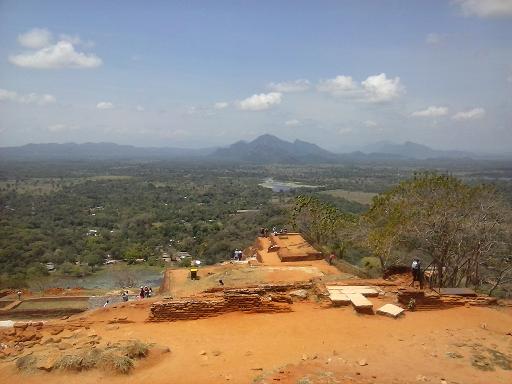
 The name refers to a site of historical and archaeological significance that is dominated by a massive column of rock nearly 200 metres (660 ft) high. According to ancient Sri Lankan legend the this site was selected by King Kasyapa for his new capital, his reign was from 477 to 495 AD. He built his palace on the top of this rock and decorated its sides with colourful frescoes. On a small plateau about halfway up the side of the rock he built a gateway in the form of an enormous lion, the paws of which are visible to this day. The name of this place is derived from this structure — Sigirya the Lion Rock. The capital and the royal palace were abandoned after the king's death. It was used as a Buddhist monastery until the 14th century.
The name refers to a site of historical and archaeological significance that is dominated by a massive column of rock nearly 200 metres (660 ft) high. According to ancient Sri Lankan legend the this site was selected by King Kasyapa for his new capital, his reign was from 477 to 495 AD. He built his palace on the top of this rock and decorated its sides with colourful frescoes. On a small plateau about halfway up the side of the rock he built a gateway in the form of an enormous lion, the paws of which are visible to this day. The name of this place is derived from this structure — Sigirya the Lion Rock. The capital and the royal palace were abandoned after the king's death. It was used as a Buddhist monastery until the 14th century.
Sigiriya is also well known for the Maidens of the Clouds, paintings of 21 beautiful women found on a sheltered ledge.
The climb up the rock is by way of a metal staircase, thankfully there were handrails and the sheer number of local people visiting allowed us tourists to take it easy and enjoy the views.
From the top the views were quite spectacular and fortunately a cool breeze eased the pain
Habarana-Dambulla-Matale-Kandy
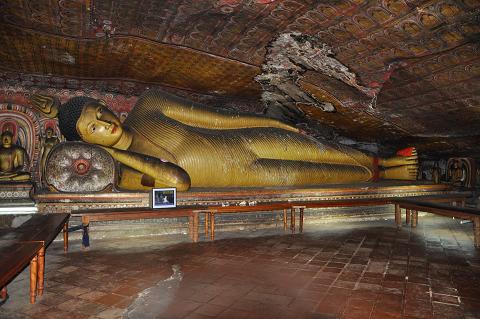 Today on the way to Kandy, we visited the Dambulla Cave Temple. This impressive site has five caves which contains carved icons and a vast amount of centuries old wall murals. Quite a few steps to be climbed but a cool breeze made it easier. During our lunch stop at Matale spice garden we were treated to firstly a tour of the gardens by a somewhat exuberant “Doctor”. The Dr and his trainees then conducted a clinic which in his words they would cure all aches and pains with simply the application of Red Oil and Aloe-Vera. However later on some of the “patients” felt worse than before. Needless to say he also had a shop where these wonder remedies could be purchased. I didn’t bother.
Today on the way to Kandy, we visited the Dambulla Cave Temple. This impressive site has five caves which contains carved icons and a vast amount of centuries old wall murals. Quite a few steps to be climbed but a cool breeze made it easier. During our lunch stop at Matale spice garden we were treated to firstly a tour of the gardens by a somewhat exuberant “Doctor”. The Dr and his trainees then conducted a clinic which in his words they would cure all aches and pains with simply the application of Red Oil and Aloe-Vera. However later on some of the “patients” felt worse than before. Needless to say he also had a shop where these wonder remedies could be purchased. I didn’t bother.
We then continued to Kandy for a two-night stay.
Kandy-Pinnawela-Kandy
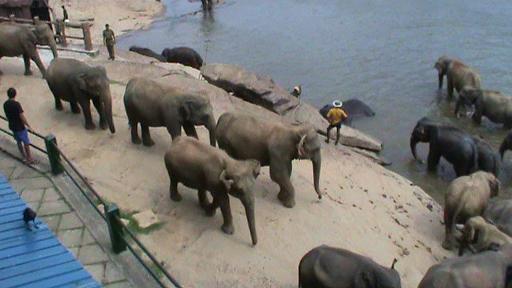 This morning we visited the Pinnawela Elephant Orphanage, there are around 60 orphaned or deserted elephants here. I was surprised to see that they were only contained within a circle of large boulders, yet they seemed to know how close they could come to visitors, but there were keepers watching over their movements. At around 12.30 the baby elephants were bottled fed and this was a great draw for all visitors, the youngsters had a voracious appetite for the bottled milk.
This morning we visited the Pinnawela Elephant Orphanage, there are around 60 orphaned or deserted elephants here. I was surprised to see that they were only contained within a circle of large boulders, yet they seemed to know how close they could come to visitors, but there were keepers watching over their movements. At around 12.30 the baby elephants were bottled fed and this was a great draw for all visitors, the youngsters had a voracious appetite for the bottled milk.
During our lunch in the restaurant overlooking the river we were able to watch the elephants bathing.
Another visit was to the Sri Dalada Maligawa or the Temple of the Sacred Tooth Relic it is a Buddhist temple in Kandy, located in the royal palace complex of the former Kingdom of Kandy, which houses the relic of the tooth of the Buddha. Since ancient times, the relic has played an important role in local politics because it is believed that whoever holds the relic holds the governance of the country. Kandy was the last capital of the Sri Lankan kings and is a World Heritage Site mainly due to the temple. Bhikkhus of the two chapters of Malwatte and Asgiriya conduct daily worship in the inner chamber of the temple.  Rituals are performed three times daily: at dawn, at noon and in the evenings. On Wednesdays there is a symbolic bathing of the relic with an herbal preparation made from scented water and fragrant flowers called Nanumura Mangallaya. This holy water is believed to contain healing powers and is distributed among those present.
Rituals are performed three times daily: at dawn, at noon and in the evenings. On Wednesdays there is a symbolic bathing of the relic with an herbal preparation made from scented water and fragrant flowers called Nanumura Mangallaya. This holy water is believed to contain healing powers and is distributed among those present.
The temple sustained damage from bombings by the Liberation Tigers of Tamil Eelam in 1998 but was fully restored each time.
Kandy
This morning we stopped at a Commonwealth War Graves Commission Cemetery near to the hotel.
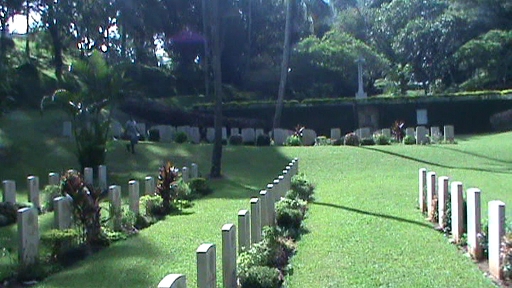 Formerly known as Pitakande Military Cemetery, it was acquired originally by the military authorities, and was subsequently taken over by the Commission as a permanent war cemetery.
Formerly known as Pitakande Military Cemetery, it was acquired originally by the military authorities, and was subsequently taken over by the Commission as a permanent war cemetery.
The Army Graves Service transferred to this cemetery war graves from a variety other burial sites.
There is a Special Memorial commemorating a naval man known to have been buried in the cemetery but whose grave could not be precisely located. It bears the superscription "Buried near this spot". There is 1 Commonwealth burial of the 1914-1918 war and a further 196 Commonwealth burials of the 1939-1945 war commemorated here. In addition there are 4 Foreign National and 2 non world war burials.
In keeping with other CWGC cemeteries it is maintained by local people and kept immaculately .
PERADENIYA BOTANICAL GARDEN
As Sri Lanka’s largest garden an elegant and spacious 147-acres, we had some time to stroll the gardens and in particular the imposing Avenue of Royal Palms.
There are some 4,000 different species of plants in the Gardens. The 10,000 or so trees, which are the stars, are mature, lofty giants, many of them tropical timber trees. Highlights of the collection include the Giant Bamboo of Burma, capable of growing to 40 meters height (130 feet) with a 25-centimetre (10-inch) stem diameter. And it can grow by a rapid 30 centimeters a day (12 inches).
The gardens showcase all of Sri Lanka’s flora and representative species from around the tropical world. Luminaries as varied as Queen Elizabeth II , Marshal Tito and Yuri Gugarin have planted trees to mark their visits to the garden.
Kandy-Peradeniya-Nuwara Eliya
We were now on our way to Nuwara Eliya which is the heart of the tea growing region of the central highlands of Sri Lanka, formerly called Ceylon. It is at an altitude of 1,868 m (6,128 ft) and is considered to be the most important location for tea production in Sri Lanka.
formerly called Ceylon. It is at an altitude of 1,868 m (6,128 ft) and is considered to be the most important location for tea production in Sri Lanka.
The first plantation on experimental stages was established in 1867 at the Loolecondera Estate situated between Kandy and Nuwara Eliya.
On the way we stopped at The Blue Field Tea Plantation and processing facility, here we saw how the tea was dried and produced into what we enjoy at home (not a tea bag in sight).
The factory shop was extremely busy with Chinese tourists who seemed to buy most of the stock.
Next day we visited the town of Nuwara Eliya and were able to experience the local market and shops. Especially interesting was the Post Office which was housed in a very grand English looking building.
Nuwara Eliya-Yala
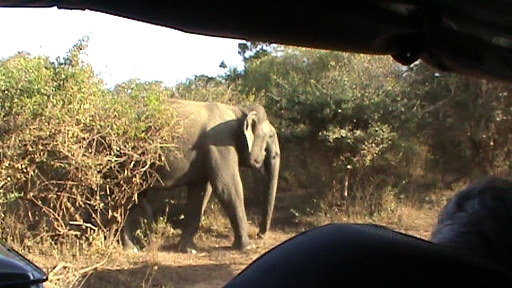 The next stop was at our hotel near Yala which borders the Yala Wildlife Sanctuary, the next morning we toured the game reserve and saw a wide range of birds and animals including elephant, crocodile, monkeys, water buffalo and many more.
The next stop was at our hotel near Yala which borders the Yala Wildlife Sanctuary, the next morning we toured the game reserve and saw a wide range of birds and animals including elephant, crocodile, monkeys, water buffalo and many more.
The hotel at Yala was made up of individual cabins within the grounds and as the animals roamed wild, an escort was needed during the hours of darkness.
Yala-Bundala-Galle-Beruwala
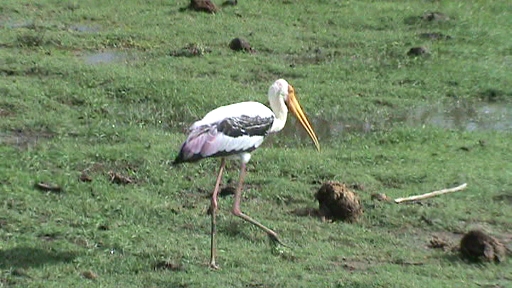 Early next morning we travelled to Bundala Bird Sanctuary
Early next morning we travelled to Bundala Bird Sanctuary
The sanctuary encompasses a pristine coastline and wetland reserve, it is a unique biodiversity spot in Sri Lanka. The park’s many lagoons attract a large number of birds offering the perfect spot for bird watching including seeing migrant species, some of which are known to have made the journey here all the way from Siberia.
From the greater flamingo to the lesser whistling duck and the black-necked stork to the spot-billed pelican, birdlife thrives at the Bundala Bird Sanctuary providing a unique opportunity to see over 150 species of these winged creatures in their natural habitat.
Beruwala
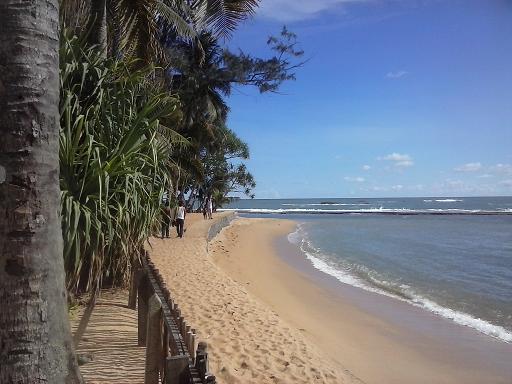 Our final stop was at the beach resort of Beruwala, it is Sri Lanka’s resort destination par excellence and our hotel was right on the beach and provided a safe bathing lagoon on which to enjoy the warm Indian Ocean.
Our final stop was at the beach resort of Beruwala, it is Sri Lanka’s resort destination par excellence and our hotel was right on the beach and provided a safe bathing lagoon on which to enjoy the warm Indian Ocean.
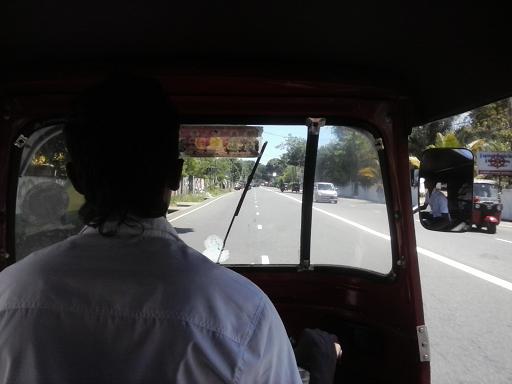 I took a Tuk Tuk into the very close by town of Aluthgama, here the local market and street traders satisfied my need to see life as it is. My driver took me in and waited an hour while I shopped, all for only GBP2.00
I took a Tuk Tuk into the very close by town of Aluthgama, here the local market and street traders satisfied my need to see life as it is. My driver took me in and waited an hour while I shopped, all for only GBP2.00
Also here we visited a Turtle Hatchery and saw youngsters from 1 day to 4 days old. There were also a few unfortunate turtles which had been injured but were now safely in the care of the hatchery.
Next stop was the airport in Colombo and the homeward flight, this was a wonderful trip and I thoroughly enjoyed every minute.
Back to top of page
